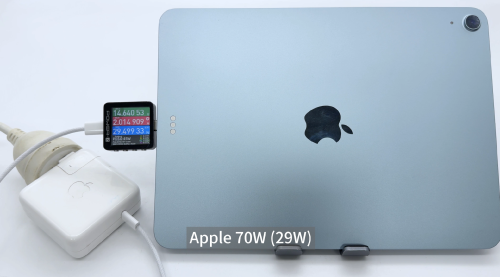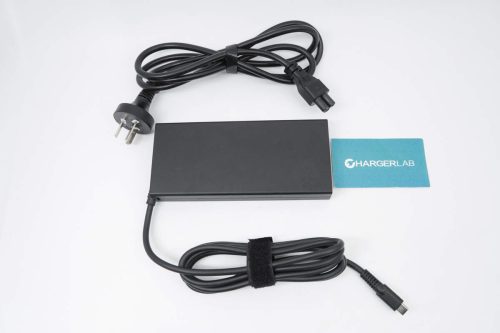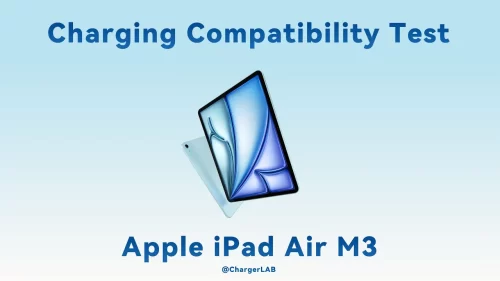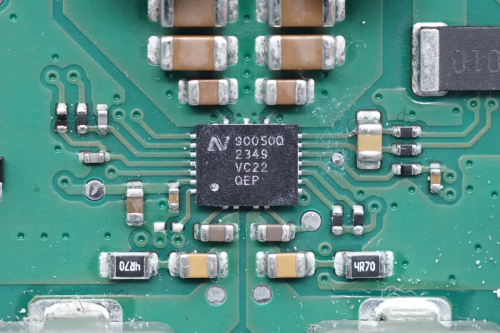ELECJET PowerPie 45W Power Bank In-Depth Review: PPS for the Win
The newly-released ELECJET PowerPie is the world's first 20,000mAh bidirectional 45W PD PPS fast charging power bank, and also the first power bank to support Samsung Galaxy Note 10+ 45W charging. The company acclaims that it offers the best-in-class PD fast charging compatibility. So today we put it into its paces and here's our in-depth review.
I Design

The ELECJET PowerPie has a rounded and sandwiched rectangular shape, a familiar form factor in the world of power banks. It features a comfortable baby skin coating and a metal brand nameplate.

In terms of size and weight, the PowerPie measures 155x70.2x24.6mm (6.10x2.76x0.96inch), which is slightly larger than an iPhone X. And it weighs 388 grams (13.7oz). Among the 20000mAh high-wattage power banks, the PowerPie is at an excellent level in terms of volume and weight control.

Take a closer look at the matte finish of the power bank.

There are LED power indicators on the side along with a dedicated PD fast charging LED indicator. In the middle is the USB-C input/outport port, and on the right is the USB-A output port.

Specifications:USB C Input: 5V/3A, 9V/3A, 12V/3A, 15V/3A, 20V/2.25A (PD); 45W MaxUSB C Output: 5V/3A. 9V/3A, 12V/3A, 15V/3A, 20V/2.25A (PD); 4.4V-11V=4.05A (PPS); 45W MaxUSB A Output: 5V/3A, 9V/2A, 12V/1.5A; 18W Max
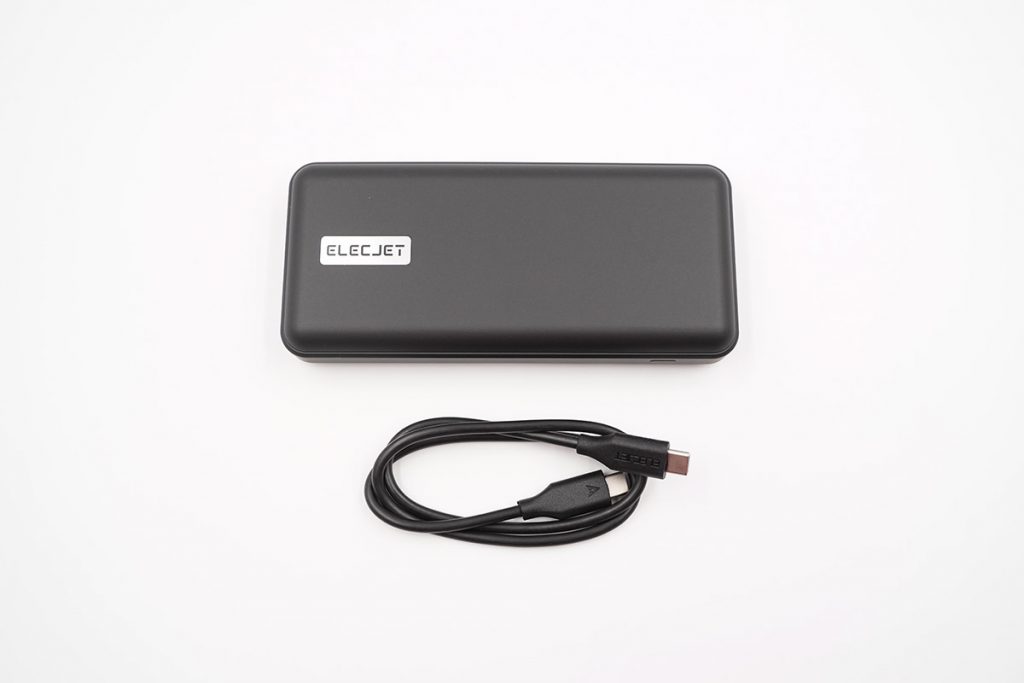
The power bank comes with a Non-Emarked 3A USB-C to USB-C cable with metal connectors and an extra clip for cable management.
II Review
1. Charging protocols test
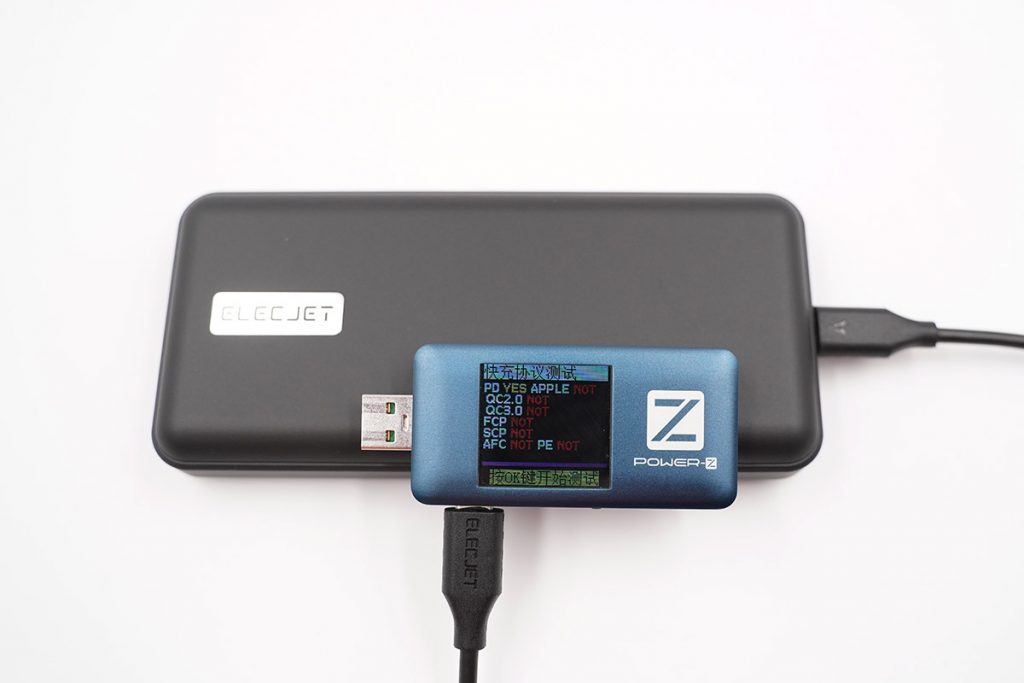
Its USB-C supports Apple 2.4A and USB-PD charging protocols.
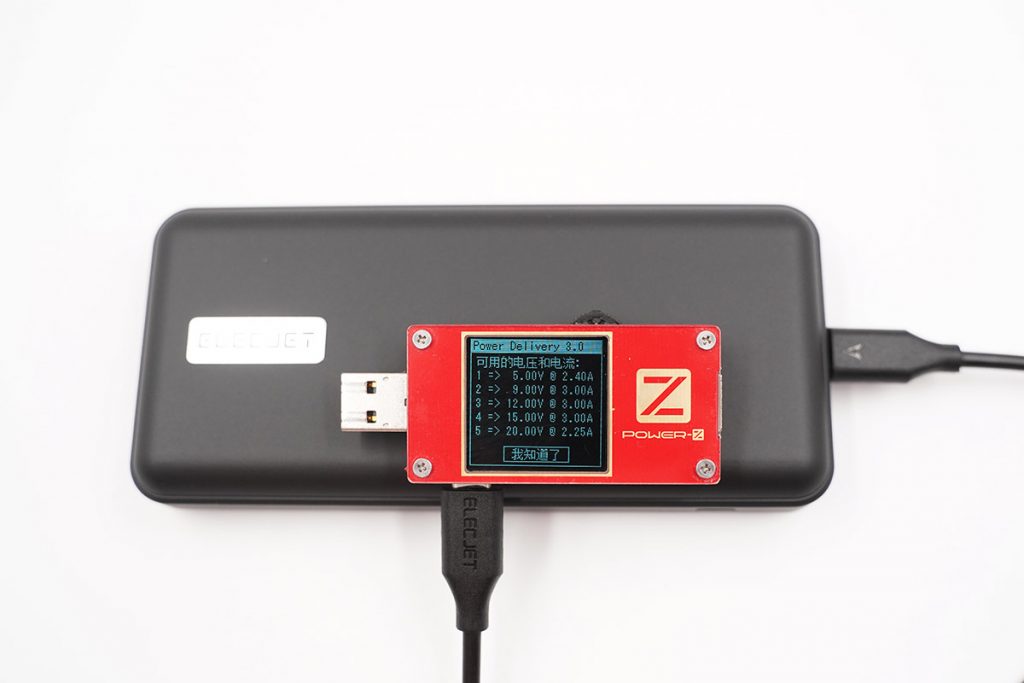
It supports the latest USB-PD 3.0 PPS standard. Fixed PDO support at 5V/3A, 9V/3A, 12V/3A, and 20V/2.25A. PPS support at 4.4V-11V/4.05A. For reference, the Samsung TA845 45W charger supports PPS at 3.3V-11V/4.05A, 3.3V-16V/2.8A, or 3.3V-21V/2.1A. So in terms of spec similarity, the PowerPie is the closest one you can get on the market right now.
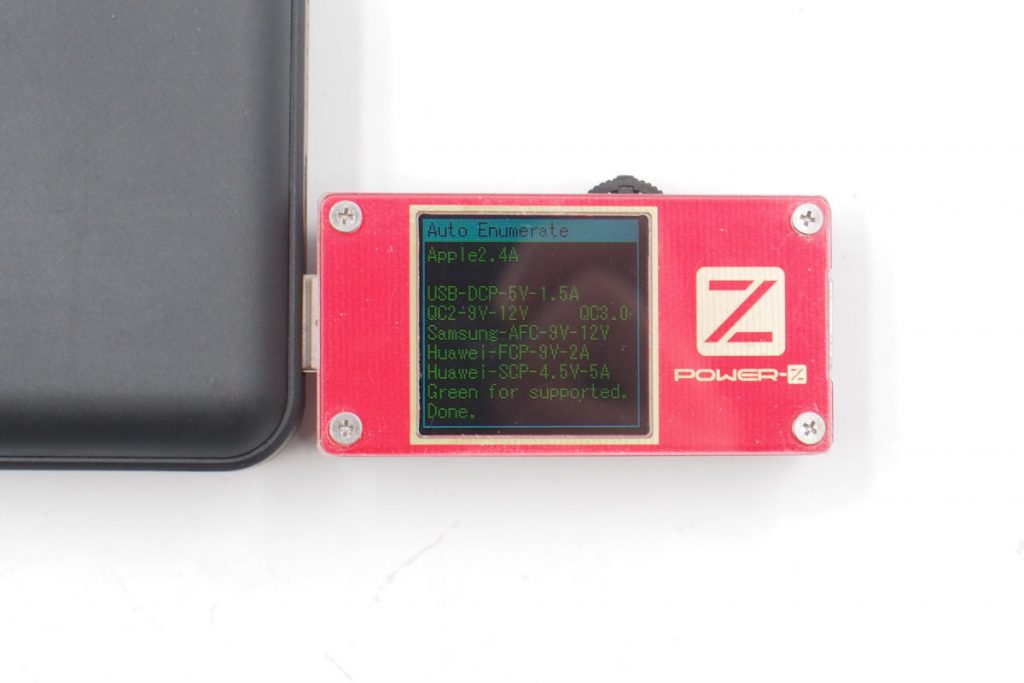
Its USB-A port supports Apple 2.4A, DCP, QC 2.0, QC 3.0, AFC, FCP, and SCP charging protocols.
2. Compatibility Test
1) USB-C output
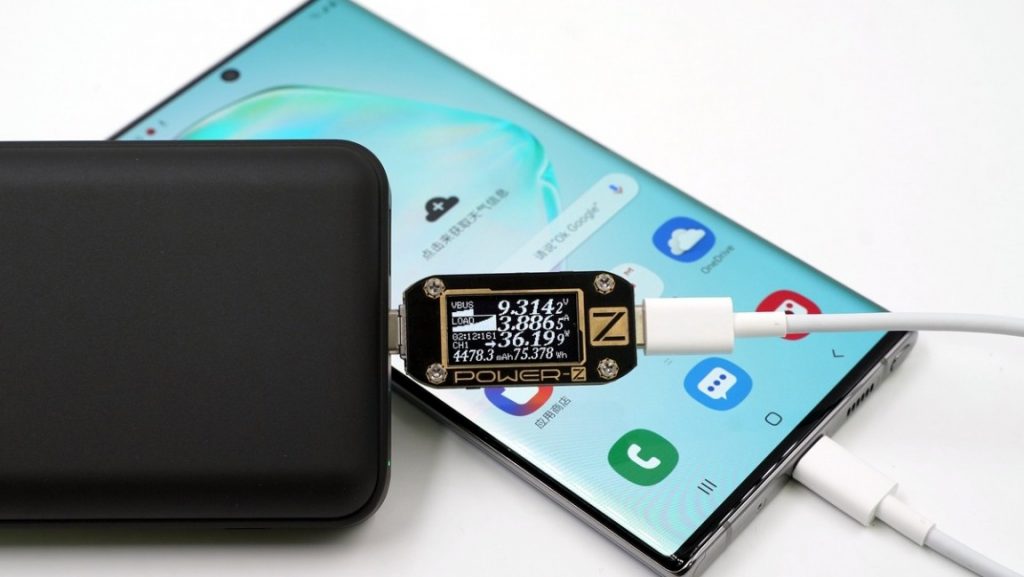
Support Note 10+ in 45W fast Charging。
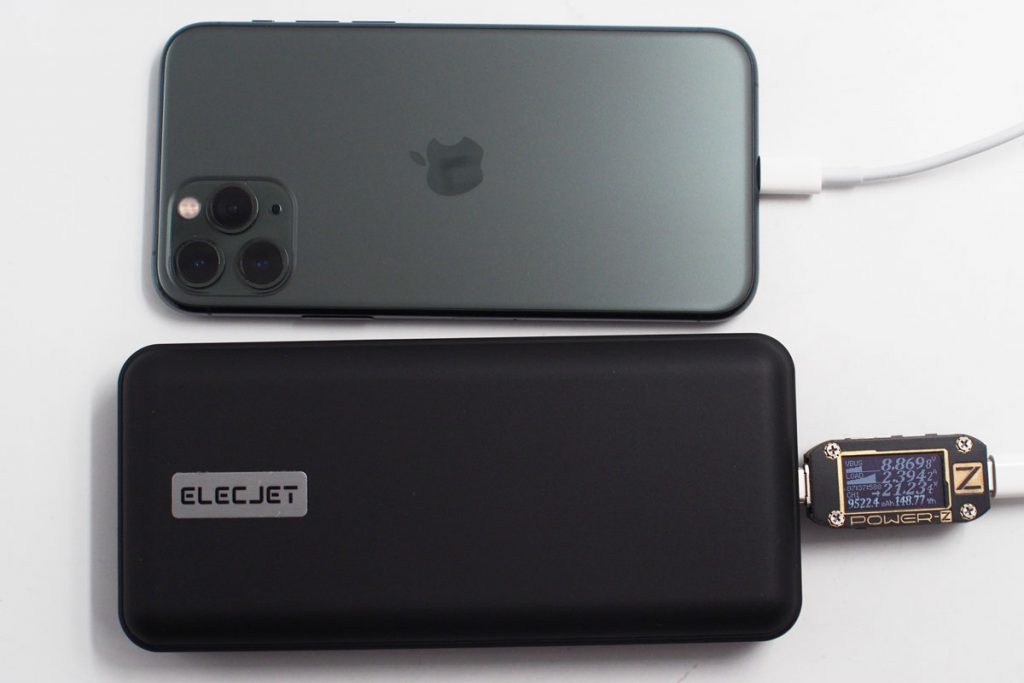
Use the USB-C port to charge the iPhone 11 Pro, we are getting 8.87V 2.39A 21.23W, under PD protocol. So the PowerPie charges a little faster than the in-box 18W charger.
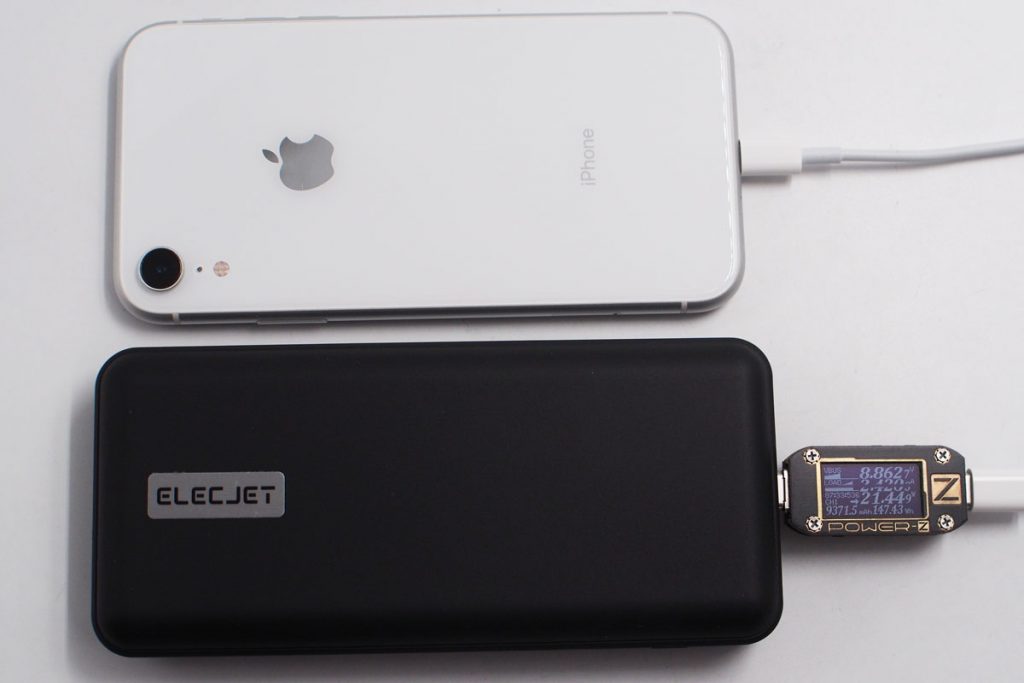
Use the USB-C port to charge the iPhone XR, we are getting 8.86V 2.42A 21.44W, under PD protocol.
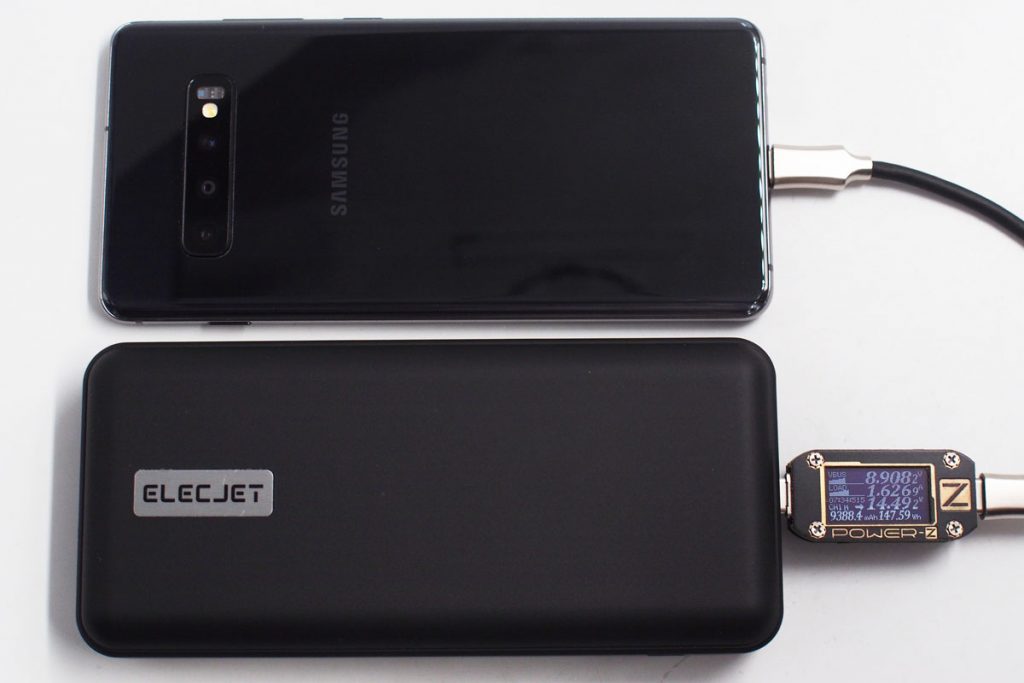
Use the USB-C port to charge the Samsung Galaxy S10+, we are getting 8.90V 1.63A 14.49W, under PD protocol.
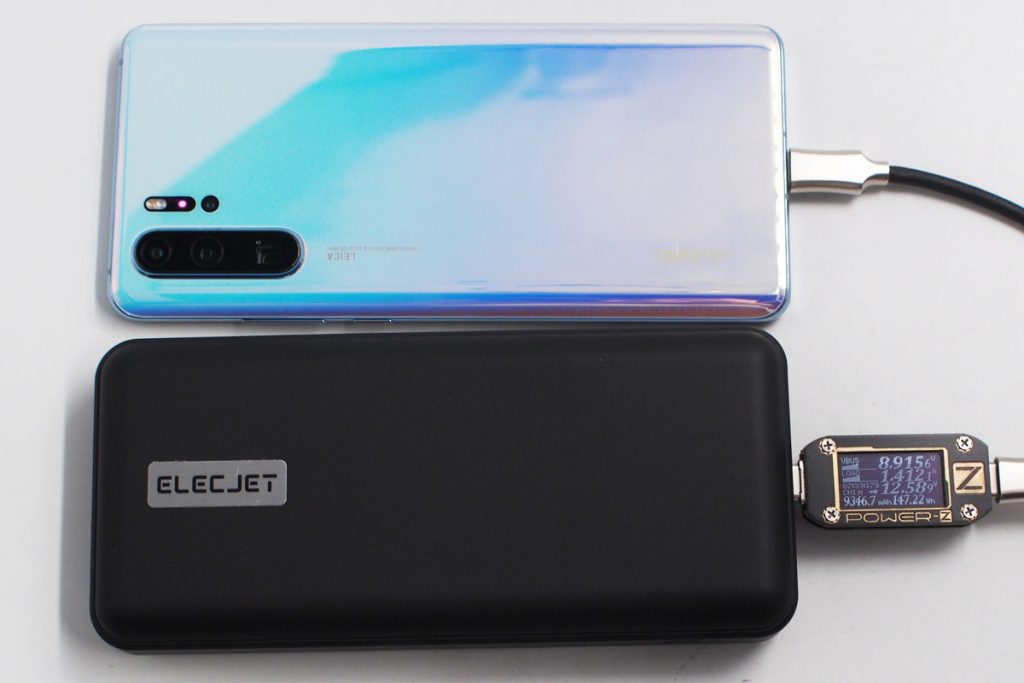
Use the USB-C port to charge the Huawei P30 Pro, we are getting 8.92V 1.41A 12.59W, under PD protocol.
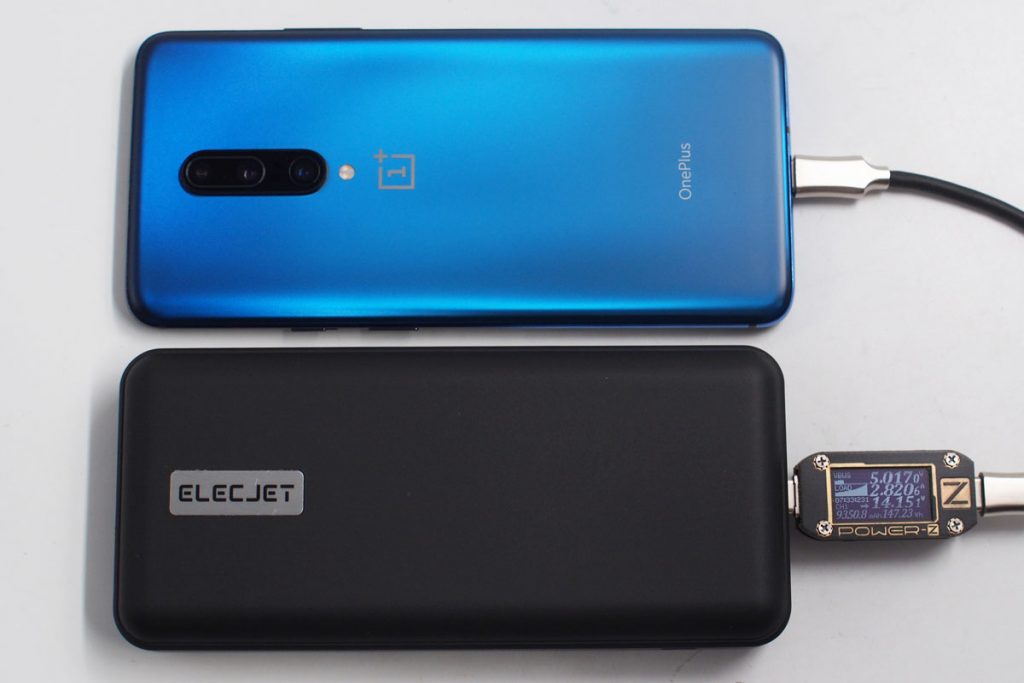
Use the USB-C port to charge the OnePlus 7 Pro, we are getting 5.02V 2.82A 14.15W, under PD protocol. 5V/3A is the fastest speed the OnePlus 7 Pro can get from a PD charger.
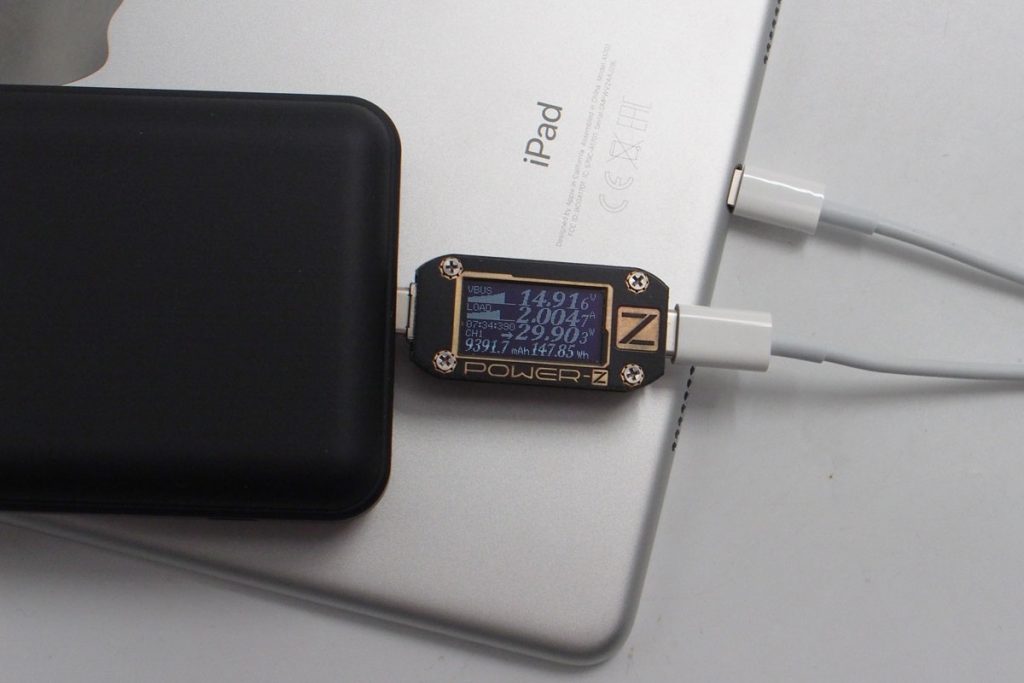
Use the USB-C port to charge the iPad Pro 10.5-inch 2017 (A1701), we are getting 14.92V 2.00A 29.90W, under PD protocol.
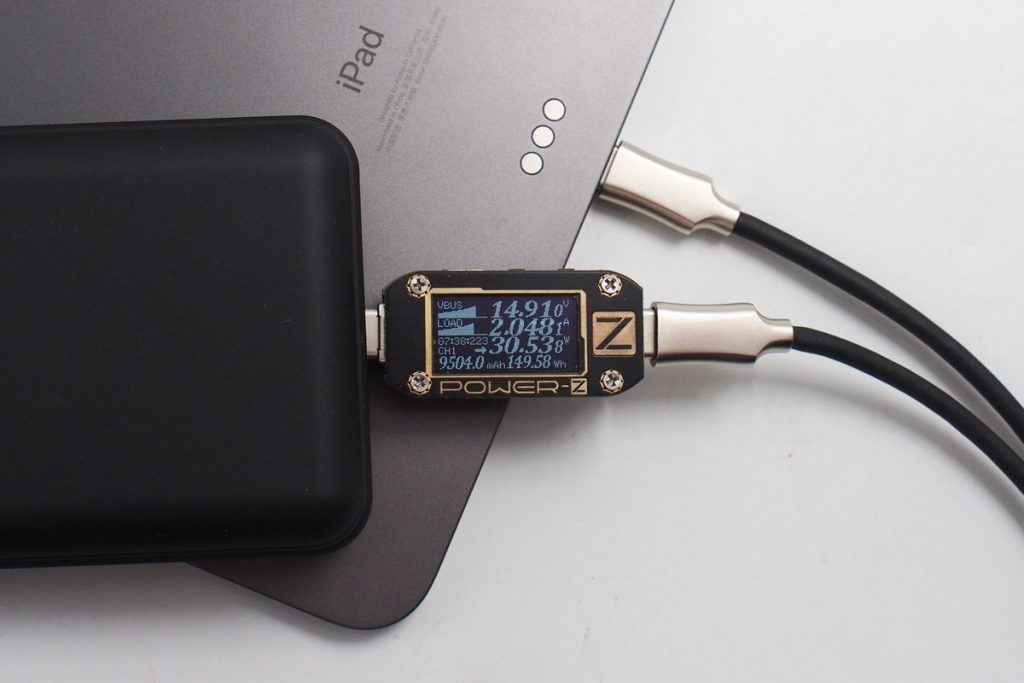
Use the USB-C port to charge the iPad Pro 11-inch 2018 (A1980), we are getting 14.91V 2.05A 30.54W, under PD protocol.
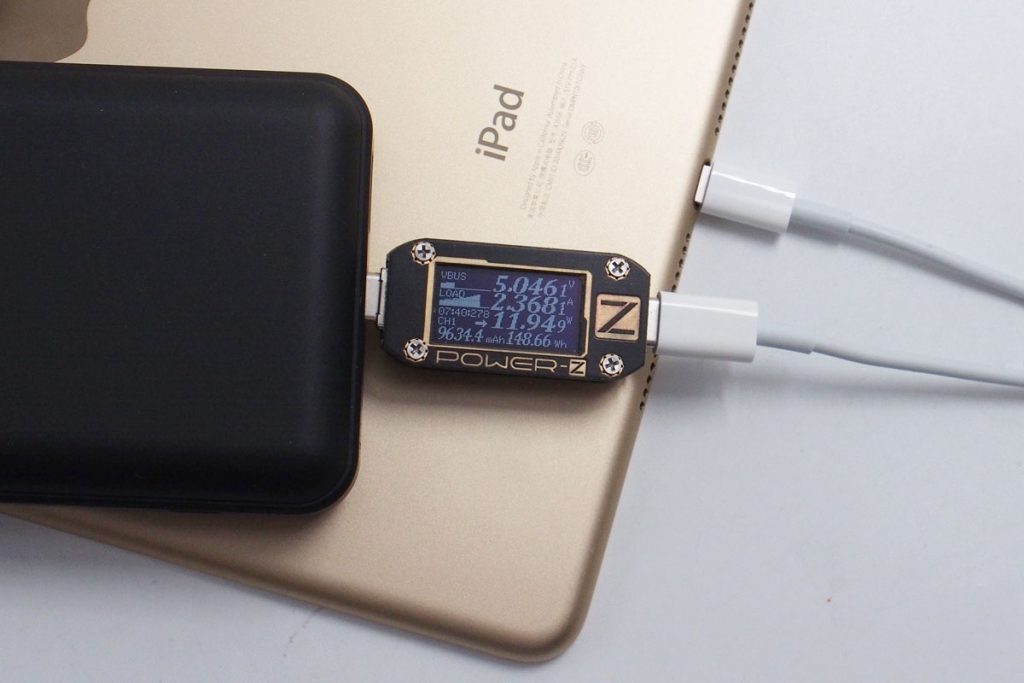
Use the USB-C port and a C-to-L cable to charge the iPad Air 2 which does not support PD, we are getting 5.05V 2.37A 11.95W, under Apple 2.4A protocol.
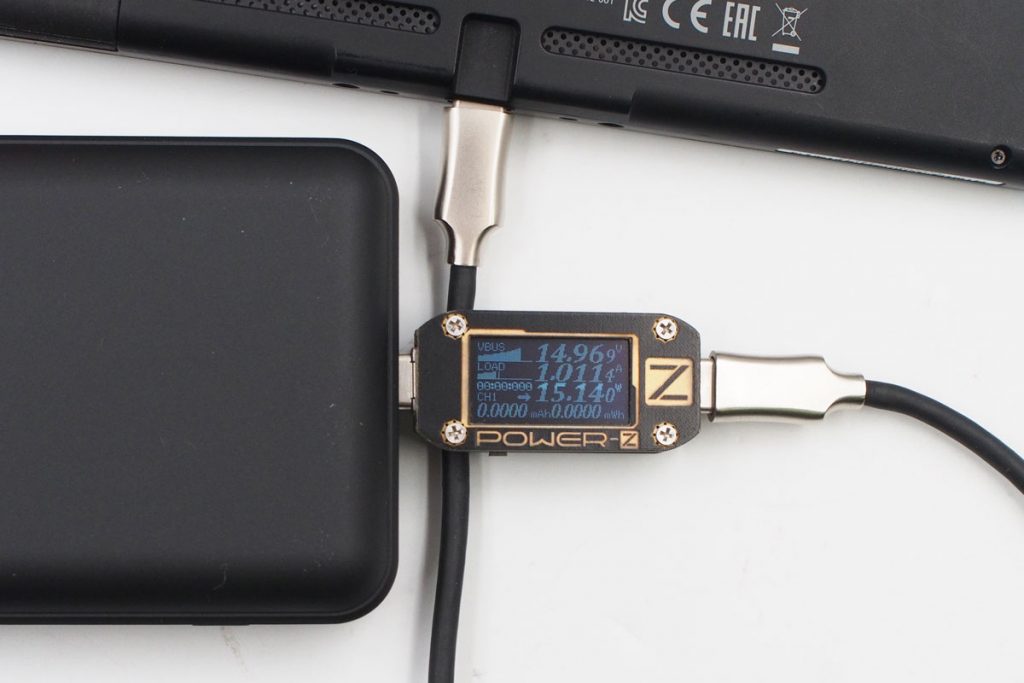
Use the USB-C port to charge the Nintendo Switch, we are getting 14.97V 1.01A 15.14W, under PD protocol.
The performance has been excellent so far. Let's see how the PowerPie charges different laptops.
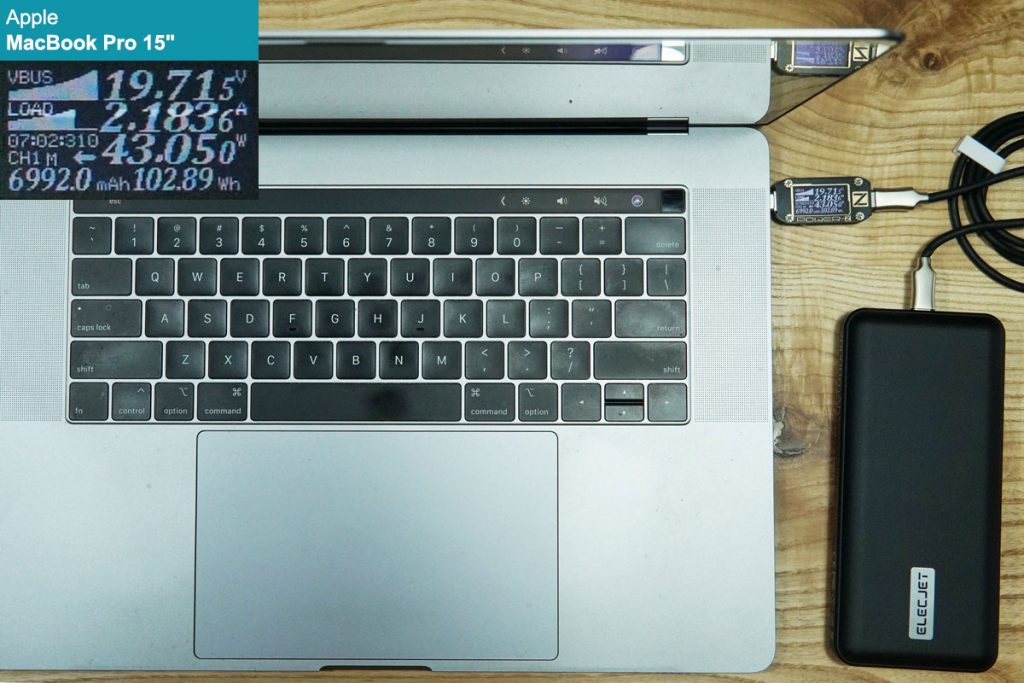
Charging the MacBook Pro 15-inch, we are getting 19.72V 2.18A 43.05W, under PD protocol.
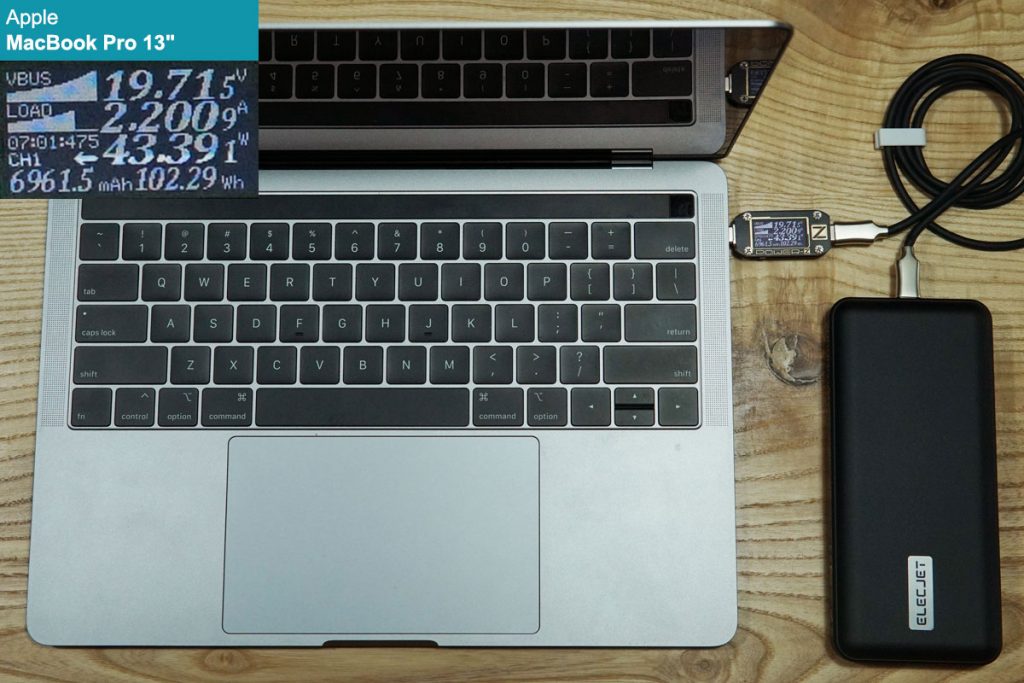
Charging the MacBook Pro 13-inch, we are getting 19.72V 2.20A 43.39W, under PD protocol.
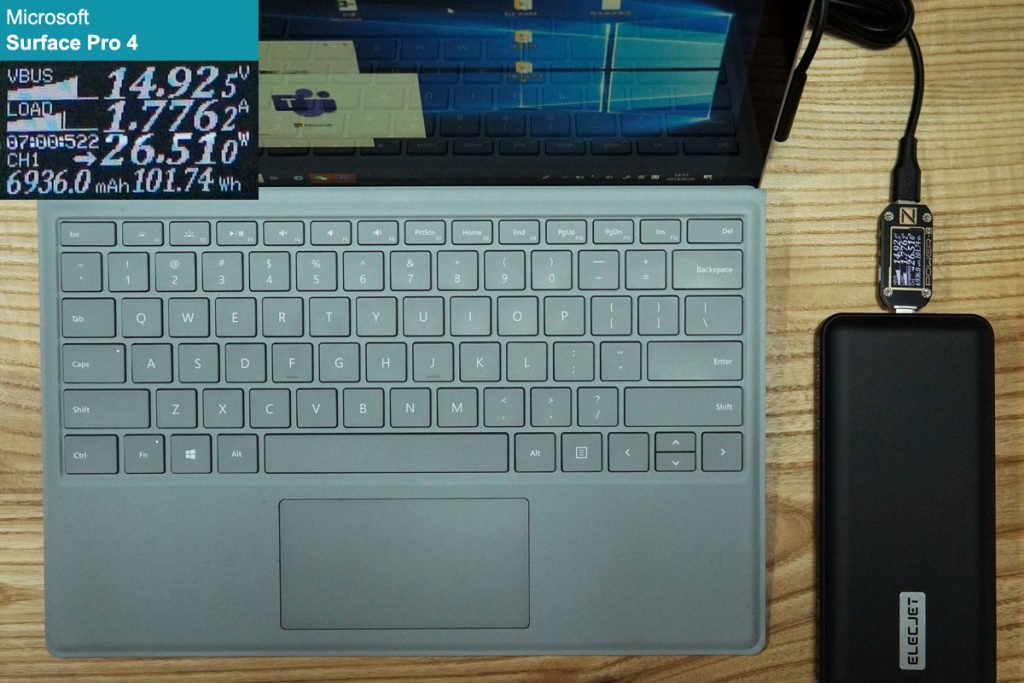
Charging the Surface Pro 4 with a USB-C to Surface Connect cable, we are getting 14.93V 1.78A 26.51W, under PD protocol.
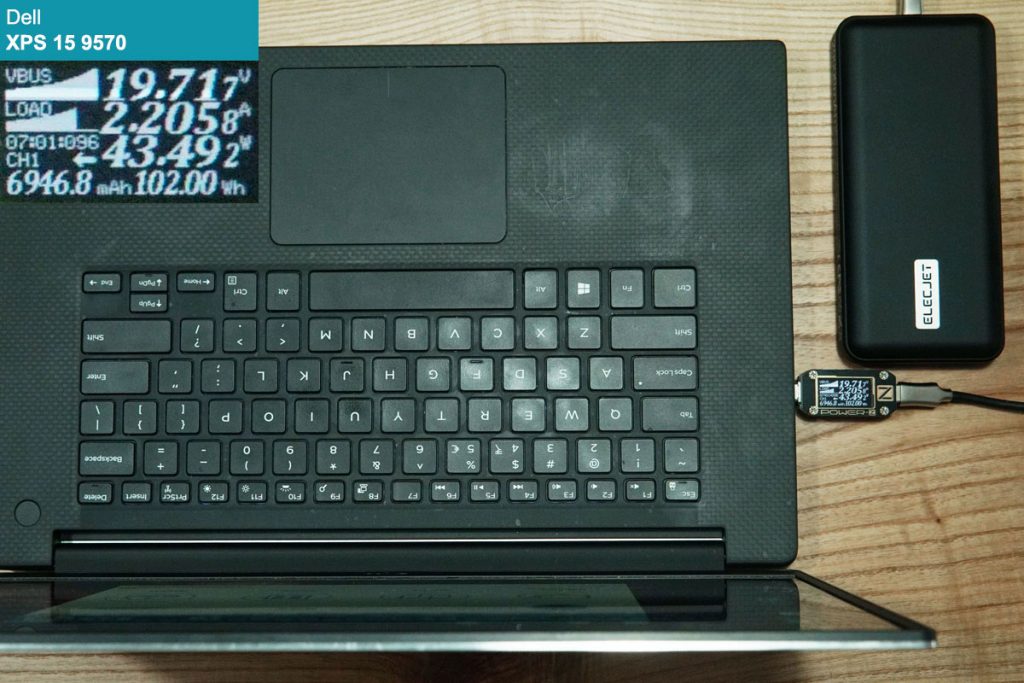
Charging the Dell XPS 15 9750, we are getting 19.72V 2.21A 43.49W, under PD protocol.
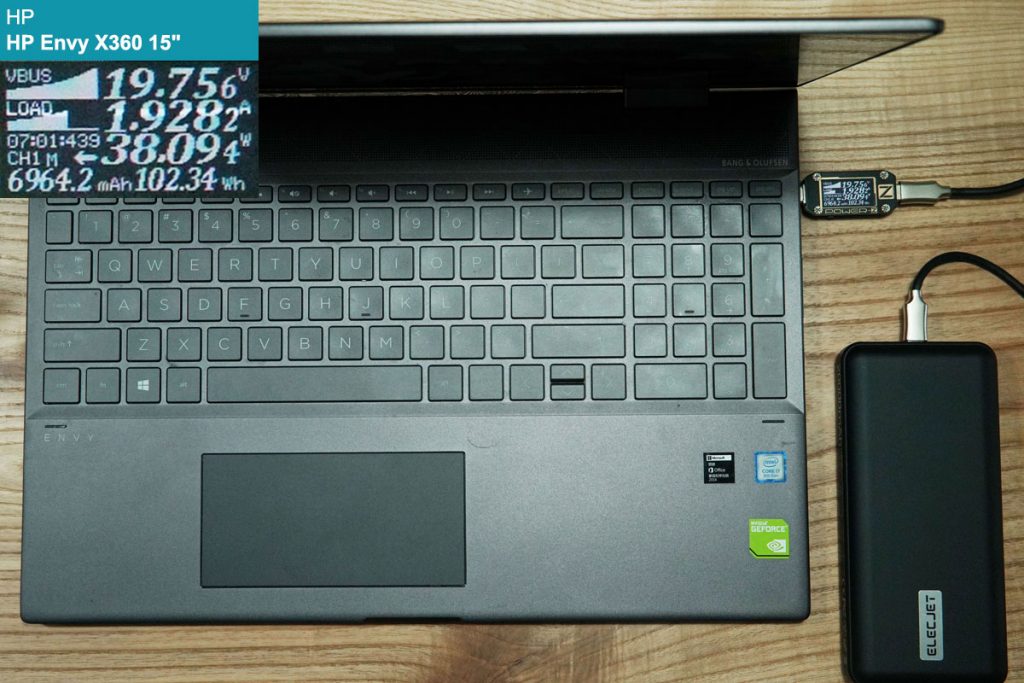
Charging the HP Envy X360 15-inch, we are getting 19.76V 1.93A 38.09W, under PD protocol.
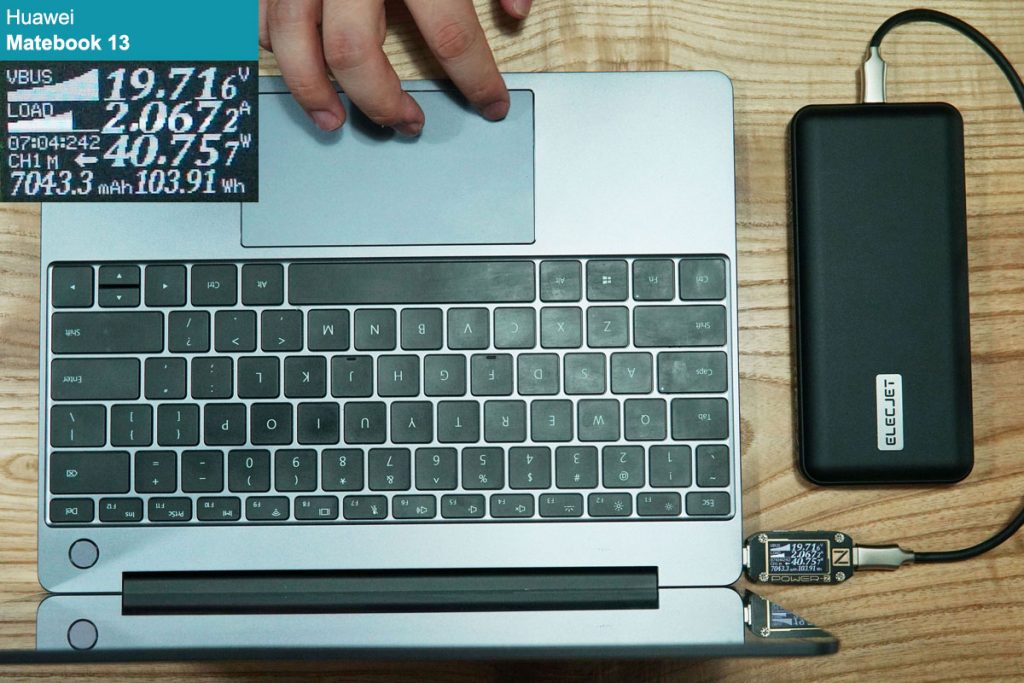
Charging the Huawei MateBook 13, we are getting 19.72V 2.07A 40.76W, under PD protocol.
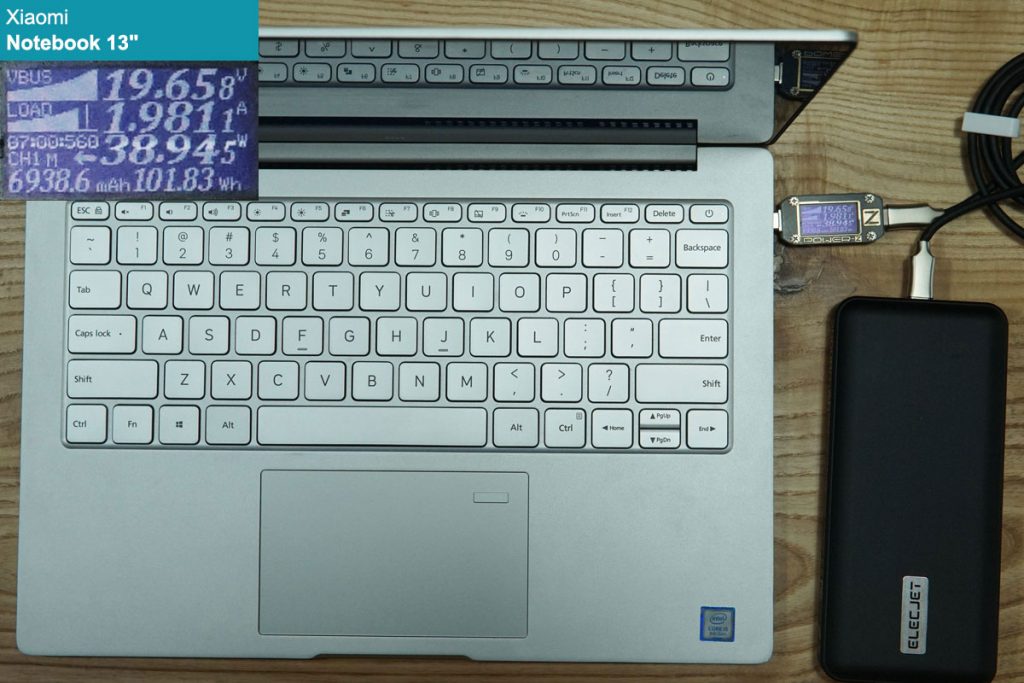
Charging the Xiaomi Notebook 13-inch, we are getting 19.66V 1.98A 38.95W, under PD protocol.
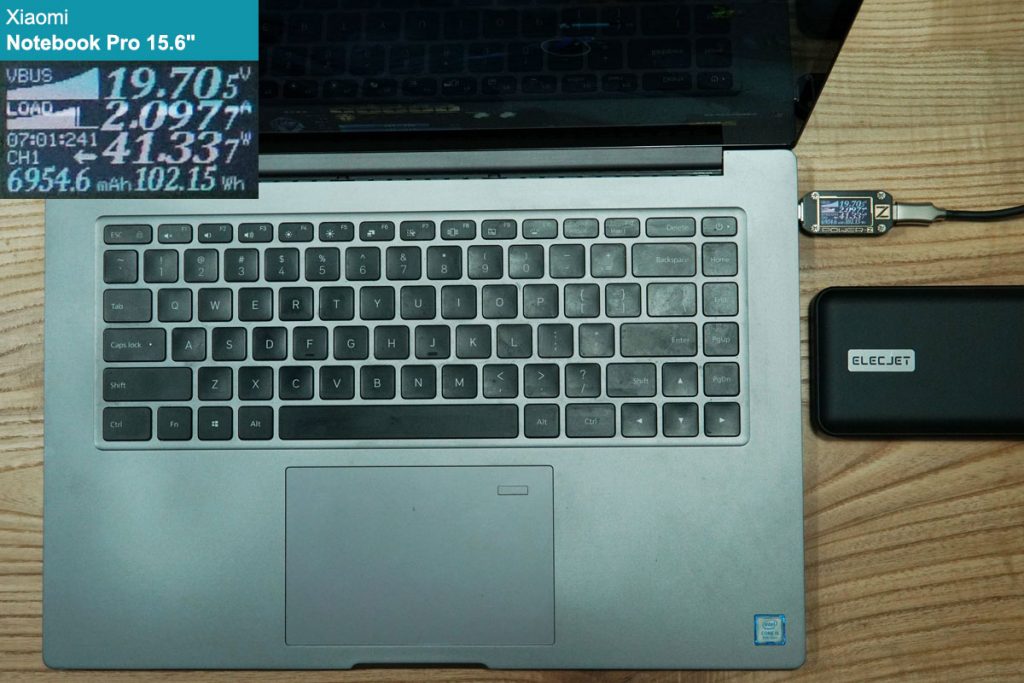
Charging the Xiaomi Notebook Pro 15.6-inch, we are getting 19.71V 2.10A 41.34W, under PD protocol.
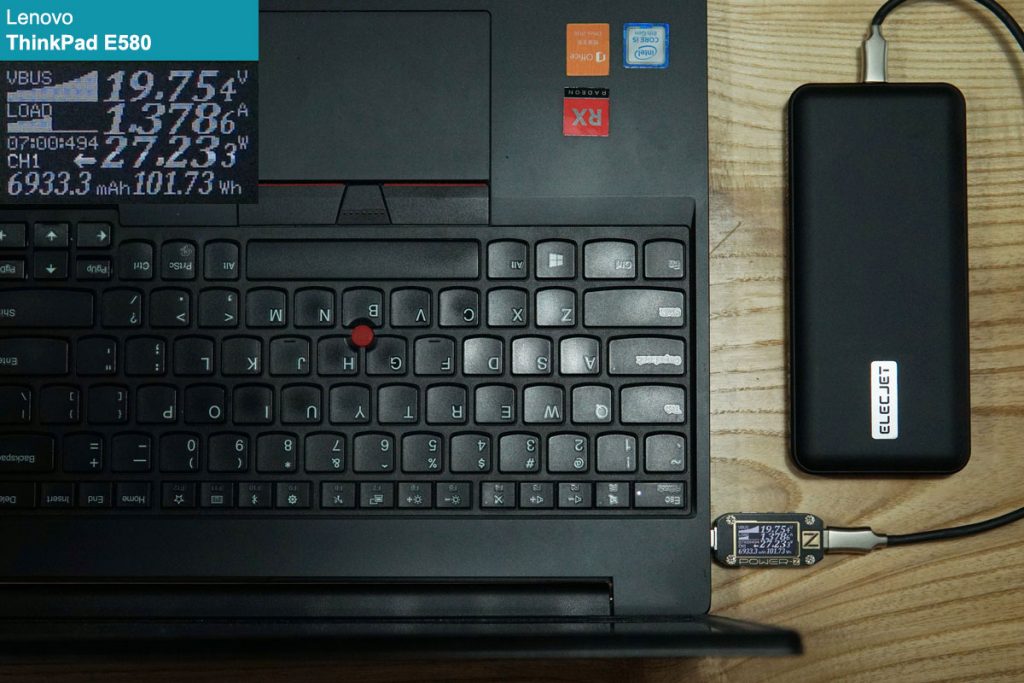
Charging the Lenovo Thinkpad E580 15.6-inch (with 80% battery left), we are getting 19.75V 1.38A 27.23W, under PD protocol.
2) USB-A output
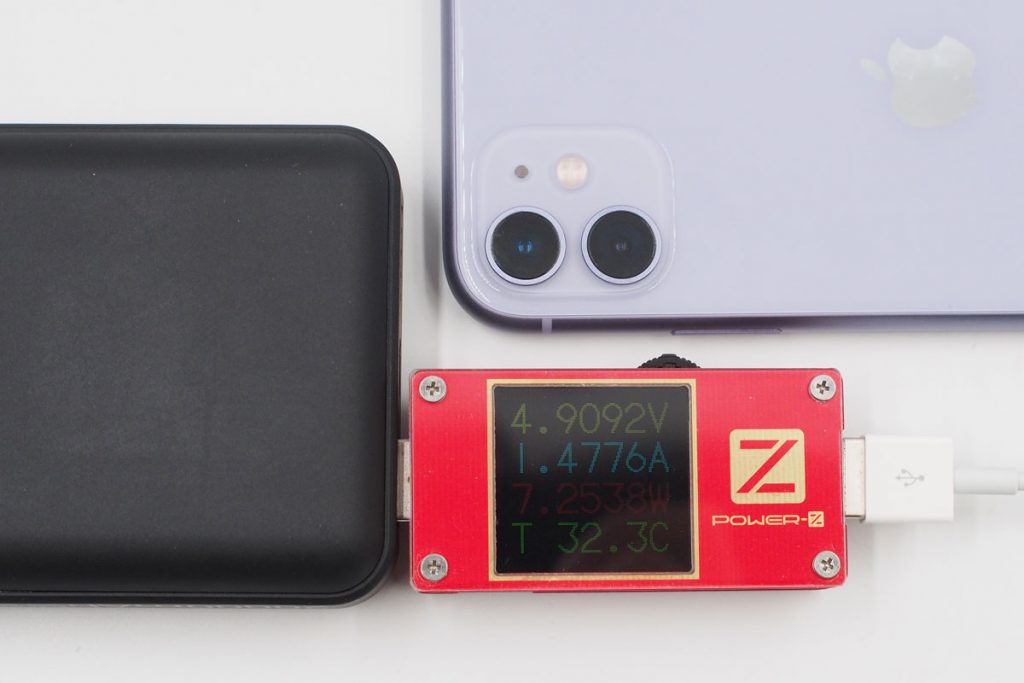
Use the USB-A port to charge the iPhone 11, we are getting 4.91V 1.48A 7.25W, under Apple 2.4A protocol.
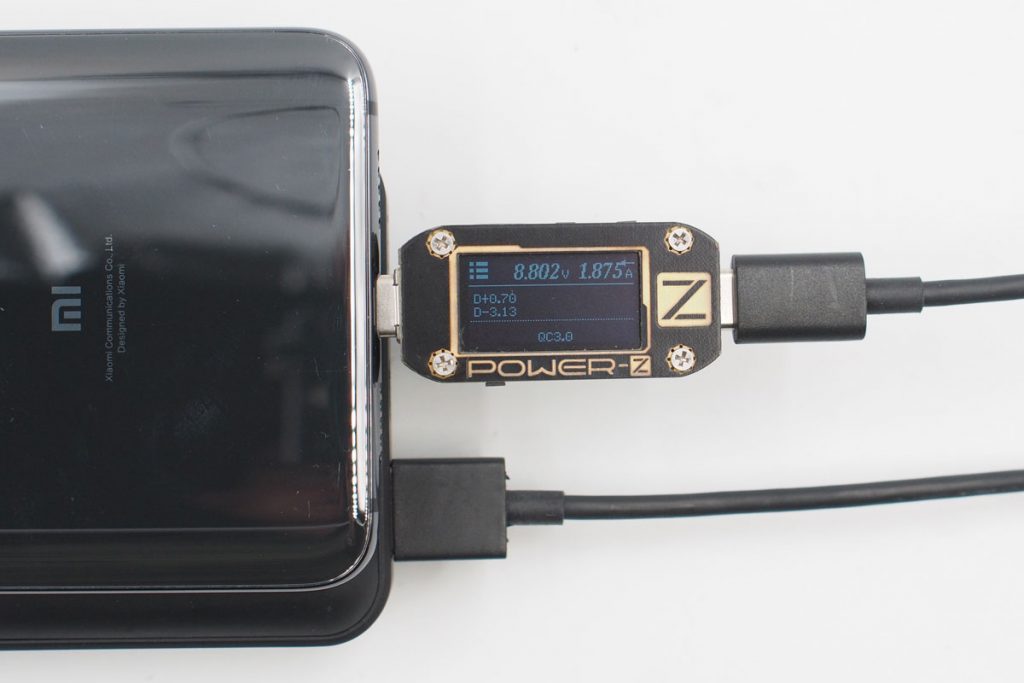
Use the USB-A port to charge the Xiaomi 9, we are getting 8.80V 1.88A 16.50W, under QC3.0 protocol.
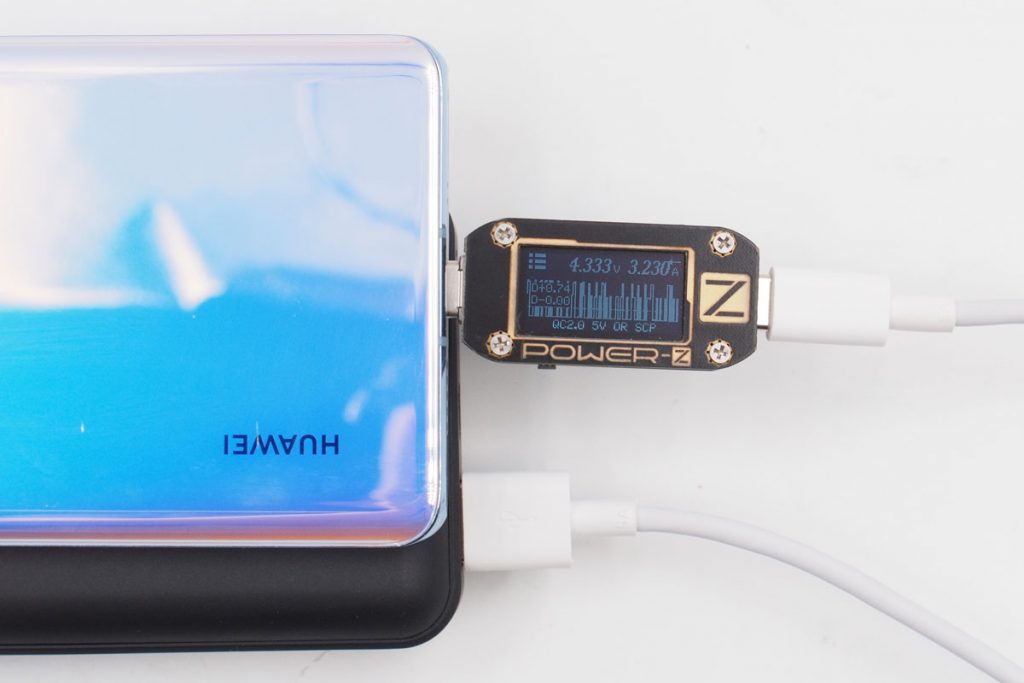
Use the USB-A port to charge the Huawei P30 Pro using the Huawei 5A USB-A to USB-C cable, we are getting 4.33V 3.23A 14.00W, under SCP protocol.
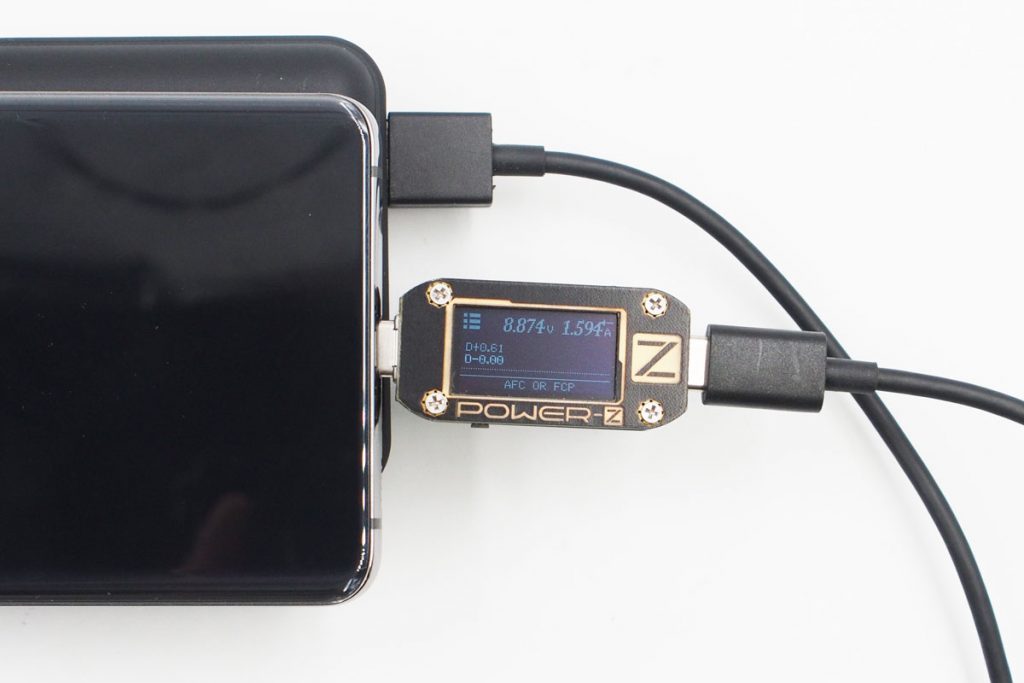
Use the USB-A port to charge the Samsung Galaxy S10+, we are getting 8.87V 1.59A 14.15W, under AFC protocol.
3) USB-C input
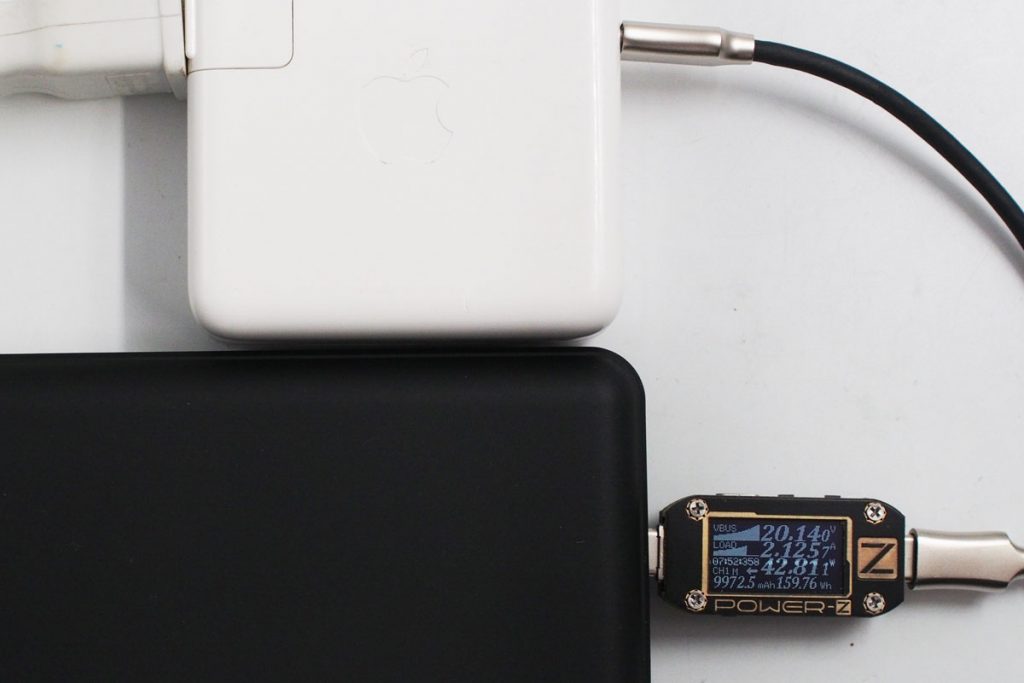
Using the Apple 87W PD charger to charge the PowerPie, we are getting 20.14V 2.13A 42.81W, under PD protocol.
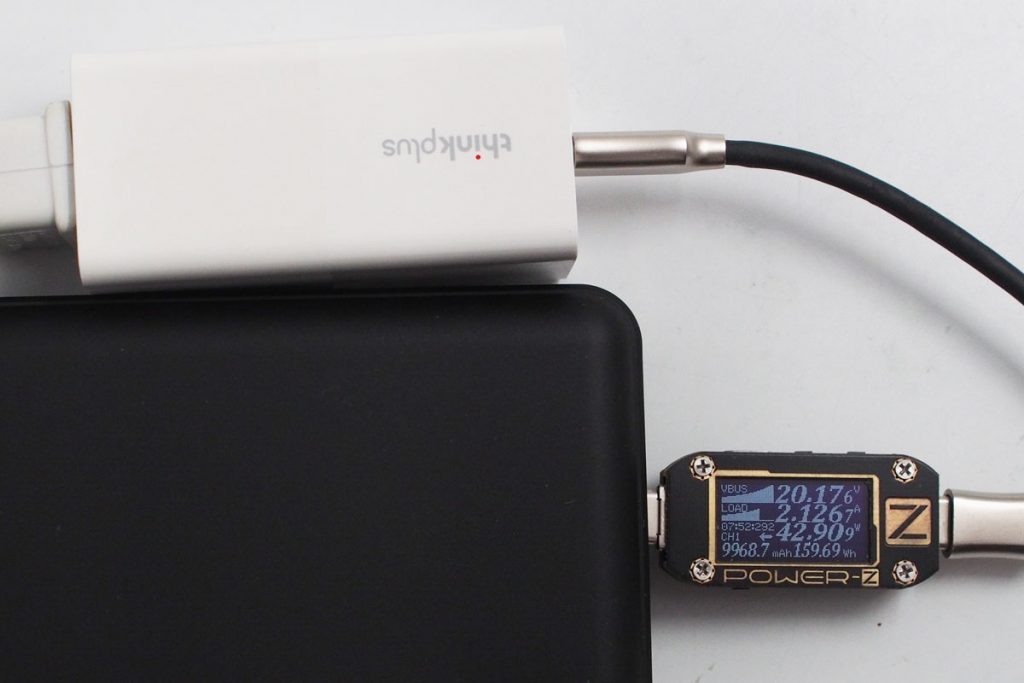
Using the thinkplus 65W PD charger (PA65) to charge the PowerPie, we are getting 20.18V 2.13A 42.91W, under PD protocol.
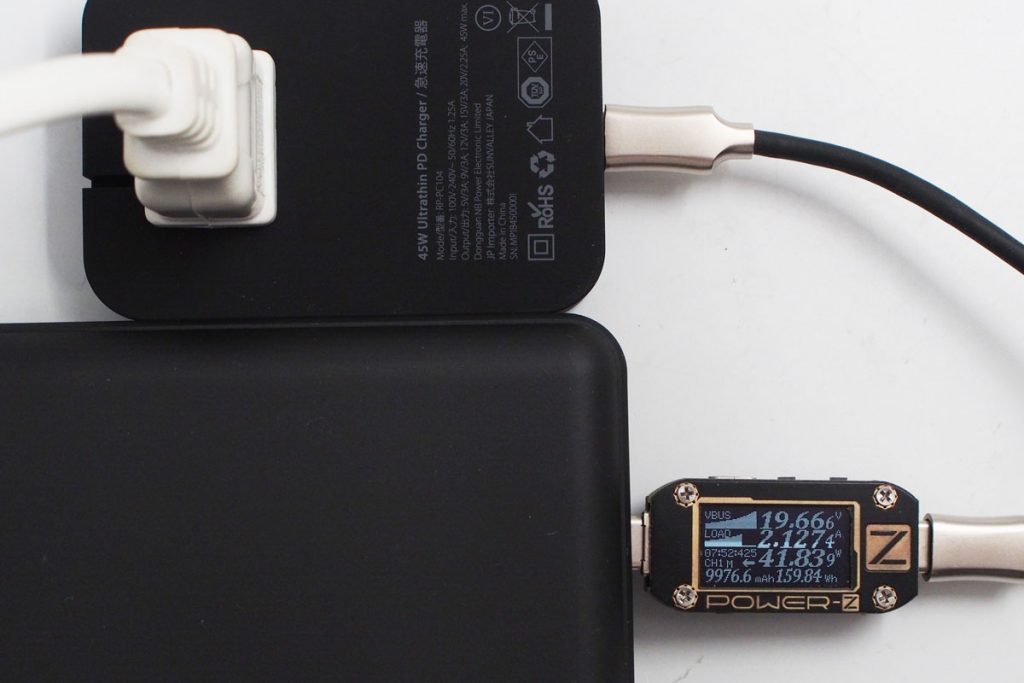
Using the RAVPower 45W Ultrathin GaN Charger to charge the PowerPie, we are getting 19.67V 2.13A 41.84W, under PD protocol.
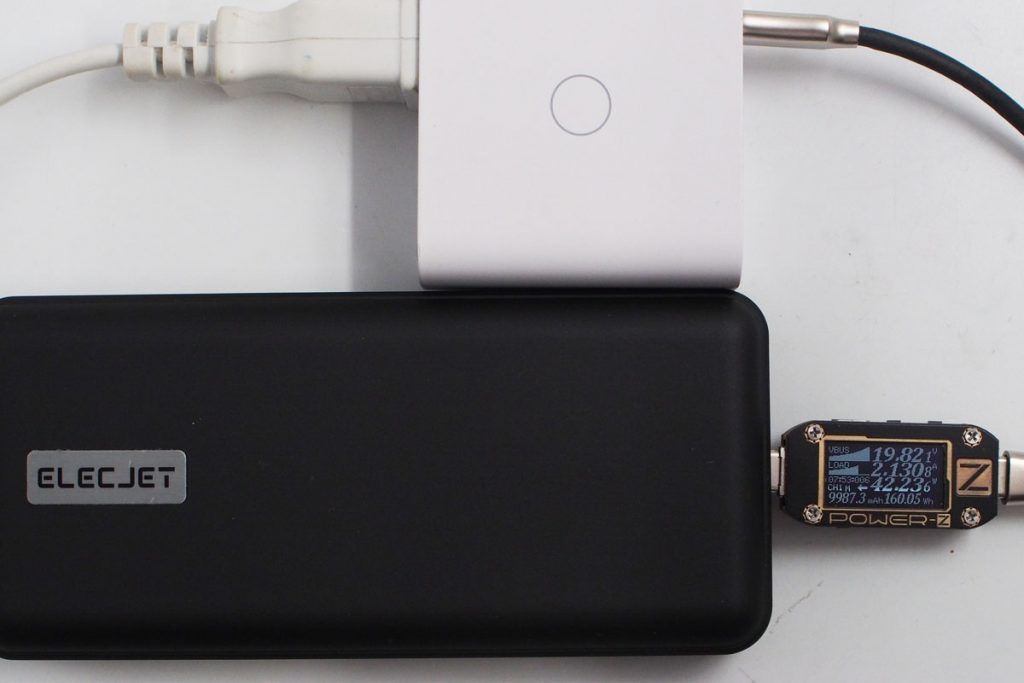
Using the ZMI 45W Multiport PPS charger (HA832) to charge the PowerPie, we are getting 19.82V 2.13A 42.24W.
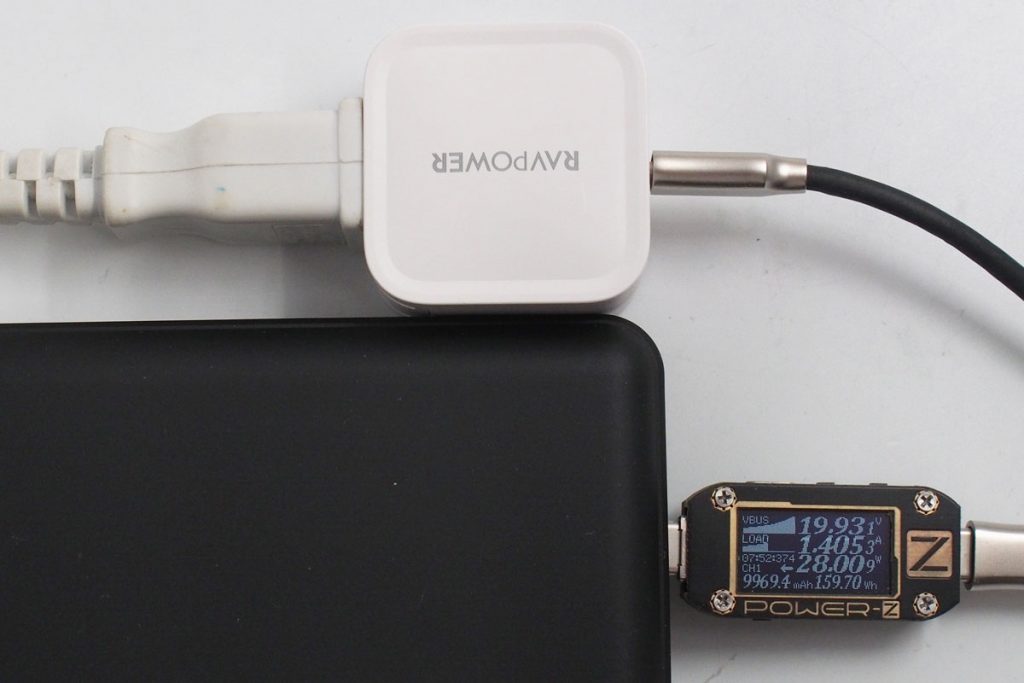
Using the RAVPower 30W GaN Charger to charge the PowerPie, we are getting 19.93V 1.41A 28.01W, under PD protocol.
4) Multiport output
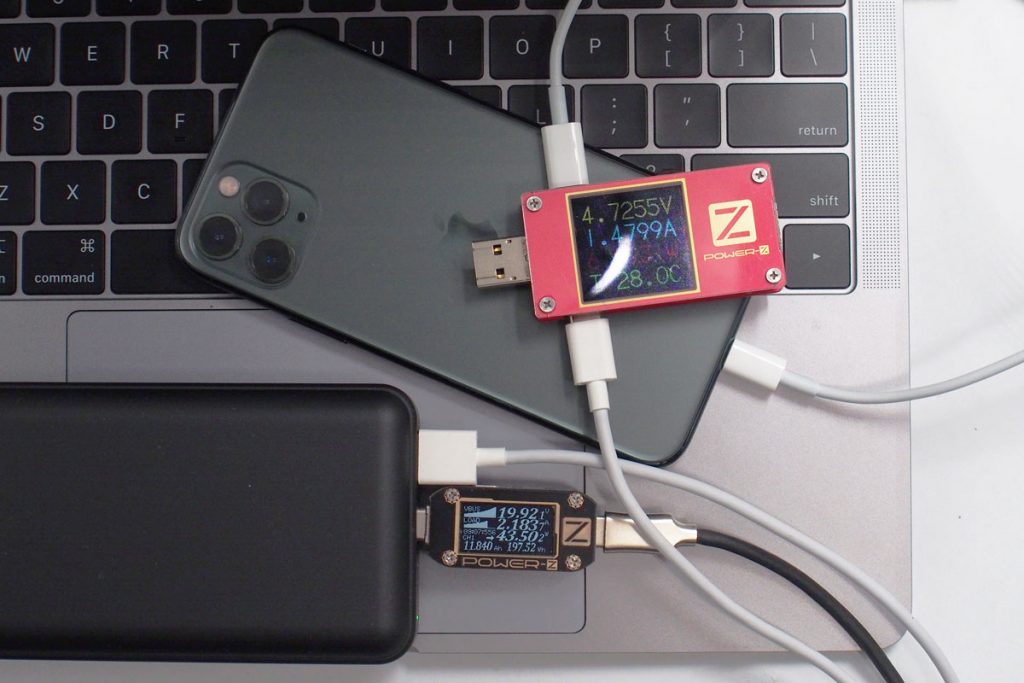
The PowerPie charges the MacBook Pro 13-inch (USB-C) and iPhone 11 Pro (USB-A) at 43.50W and 6.99W, respectively. It means that the PowerPie can be actually marketed as a 55W power bank, but the ELECJET team choose to go with a 45W title.
5) Pass through charging
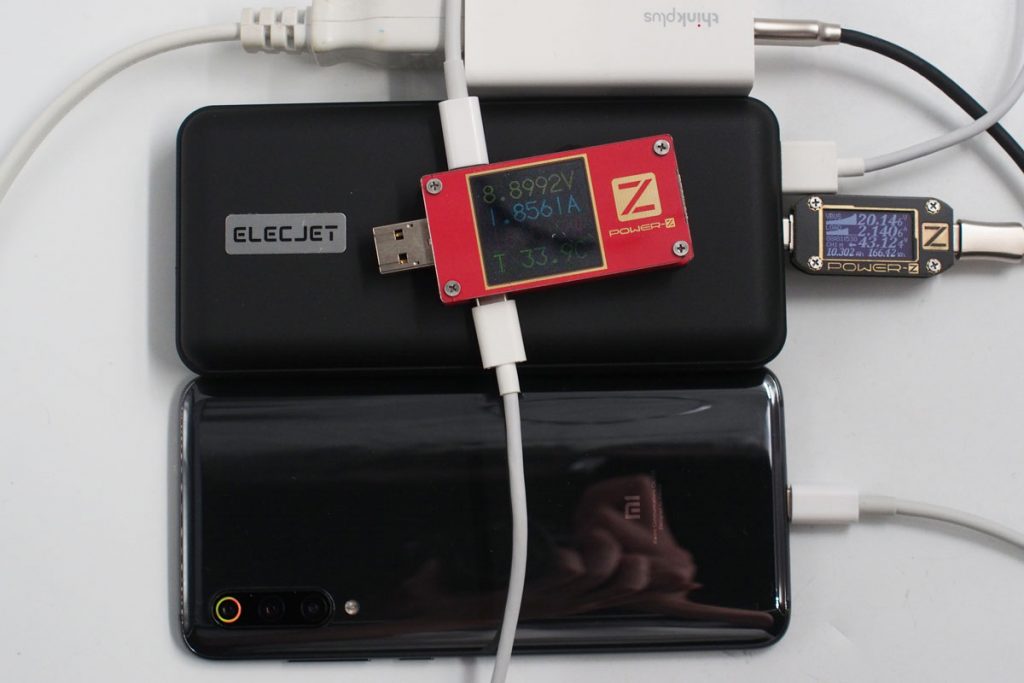
It also offers impressive pass through charging feature with 43W (20.15V/2.14A) input and 17W (8.90V/1.86A) output at the same time.
III Conclusion
I adore anything that supports USB-PD PPS. However, the industry has been moving slowly for the adoption of PPS. Naturally, PPS requires a higher cost to implement, mostly due to a higher investment in tuning and testing. But it has been two years since the release of the USB-PD PPS standard. And now, at the end of 2019, we still have countable numbers of PPS chargers on the market. Not to mention power banks.So despite being a relatively niche brand, ELECJET really sets a great example for the industry with the PowerPie, which is one of the few PPS power banks, and the only 45W PPS power bank on the market.It performed very well during our charging performance and compatibility test covering smartphones, tablets, and laptops. I love the fact that the PowerPie can output 45W and 10W with its USB-C and USB-A ports at the same time, which technically makes it a 55W power bank, but the ELECJET team choose to go pro and low-key with a 45W title (just like Belkin and other famous brands did).For a powerful and well-considered power bank like this, the asking price of $69.99 seems very reasonable. And now a pre-sale price of $49.99 just makes it even better. But we don't know how long that special offer will last, though.Our teardown of this PPS beast is also coming soon, stay tuned!
Pros:Two-way 45W PD charging and 45W+10W simultaneous output with great compatibility.The only 45W PPS power bank on the market right now.Reasonably priced.
Cons:The matte finish is relatively prone to scratching.



